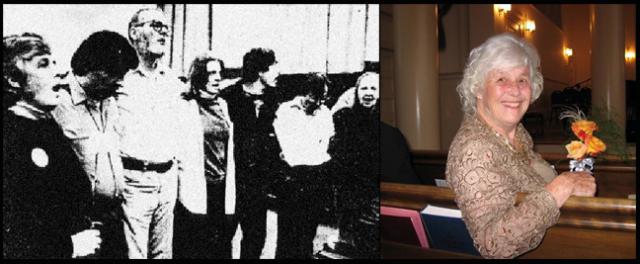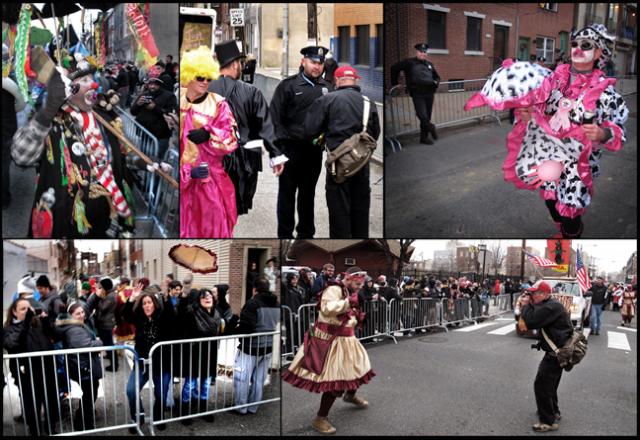Philadelphia — A number of things converged to make my New Years special this year. Three of them were good, one was not so good — in fact, it had the sense of a nasty omen for the future.
First I had a great dinner with friends, including several veterans, at a Vietnamese restaurant in Upper Darby owned by a good friend whose father was an officer in the Vietnamese ARVN army in Nha Trang. He jokes he was “born in a bunker.” He’s the epitome of the hard-working Asian, with one daughter who is a highly respected physician, another in college. When talking to Edward I always wonder what his life would have been like if the United States had had the sense to take another course than the one they did at the close of World War Two and, later, following the French defeat. We’ll never know these what-ifs.
 The Plowshares group with Agnes Bauerlein at the far left; and Agnes in more recent times
The Plowshares group with Agnes Bauerlein at the far left; and Agnes in more recent times
Today, I attended a memorial for Agnes Bauerlein, a Dutch-born peace-movement giant here in Philadelphia who recently died. She and her deceased husband, Charlie, a member of our Veterans For Peace chapter in Philly, parented 11 children. I always felt I was one of Agnes’ extended family, in a way one of her and Charlie’s “kids” as well. Agnes troubled her husband Charlie, a successful engineer with his own company, and many in her family, by devoting her life to civil disobedience. She poured blood over plans for bombs and used a hammer to dent parts for atomic bombs at an AVCO nuclear weapons plant she and others got into with fake IDs. What most impressed me was Agnes’s determination in 1991 to travel to Baghdad, where she was during the bombing that went on during the First Gulf War. Some said she was foolish and a little mad. For me, she was a courageous person who nurtured nearly a dozen kids and decided she wasn’t going to shut up and go along quietly when she saw US militarism at work. She saw the bodies of her brother and sister killed by bombs in World War Two, so unlike most of us, she well knew what she was protesting.
Agnes was born and raised in Holland and her family’s house was along the front lines at the end of the war. Her mother said opposing US military policy was wrong, because it was the US military that saved the family from the Nazis. That didn’t trouble Agnes. She blew off the criticism from the political right side of her family and followed her heart with courage and conviction, pretty much like no one else I’ve ever known. Her appeal in the AVCO case was delayed indefinitely and she never did real prison time for that offense. Charlie eventually came around and stood up for Agnes’ actions. He had voted for Reagan, but ended up a deeply committed fighter for peace. Some said, as a man and a husband, he’d lost control of his wife. He said that was nonsense: his wife Agnes had a good, honorable mind of her own and he was fine with that. Devoted Catholics, they both had a strong spiritual life, which fed into their peace work, in Charlie’s case that meant working with the VFP chapter in Philadephia.
The memorial and lunch that followed was very moving, and as I told Agnes’ son Chuck, I will be traveling to Jamaica with Agnes, her humanity and her joy of life fresh in my mind. On the third, I’m off to a Jamaican friend’s wedding in Jamaica, where I will be for two weeks. She’s an African-Jamaican artist, her mom lives in Kingston, and she’s marrying a white Georgia cracker who’s an internationally known base guitarists. I feel as a couple they’re going to shake up the world somehow. Jamaica, of course, is always having problems to accompany the amazing beauty of an island that hasn’t quite gotten over its British colonial past. The US Central Intelligence Agency went a long way in the late 1970s to destabilize the island by pouring loads of machine guns and bombs into the poor slums of places like Kingston, pitting Michael Manley’s PNP party against Edward Seaga’s JLP. Manley had been getting too friendly with Fidel on the island next door. Some say the resulting destabilization of Jamaica became permanent.
Another event that occurred for me this New Years — the one that had a bad omen scent about it — occurred in South Philly as part of the annual Mummer’s Day Parade. For some twenty years, my good friend Harvey Finkle has photographed the Mummer bands and comic performers as they march down Two Street in South Philadelphia. The Mummers Museum is at Washington Avenue at the top of what traditionally has been a more authentic, sometimes raunchy Mummers Parade. Bars are open and many houses feature hot dogs and food and drink for the revelers. It’s a great party that I always enjoy. I’ve been accompanying Harvey for over ten years to shoot the Two Street version of the parade. The Broad Street version of the parade has basically become a choreographed TV show.
An academic friend of ours has developed the idea that the Philadelphia Mummers Parade — think Mardi Gras or Carnival in sub-freezing weather — has roots in the ancient Roman Saturnalia, the one day each year when Roman slaves could send up their master and have a good time drinking and carousing. The Mummers Parade, accordingly, has a very working class flavor to it. There is, yes, lots of beer drinking and young, rambunctious males wearing colorful dresses have been known to relieve themselves on the sides of buildings as they balance their beer can in their other hand.
For years, as professional photographers we’ve “worked” the bands with our cameras in the middle of the street, getting in the middle of the various bands and comic groups. Mummers love being photographed. The warm spirit of human fellowship on New Years Day is contagious, and I always get into it and dance as I shoot. Harvey has a body of work taken at this annual Two Street parade that goes back at least 20 years. Recently the New York Times ran some of his Mummers photos taken in the streets and of the people who come out to enjoy the festivities.
 Center top, cop tells Finkle he must leave; bottom, Finkle working the street like he’s done for decades
Center top, cop tells Finkle he must leave; bottom, Finkle working the street like he’s done for decades
This year, however, we ran into what seemed to me nothing short of a case of a police state obsessed with control. For the first time ever, the entire Two Street area was blocked off by metal cattle chutes that separated the Mummers from the people on the sidewalks. That included photographers. We were both told in no uncertain terms at the top Two Street by the Mummers Museum that we had to stay on the sidewalk. As photographers with press credentials, the decision to lock the place down seemed contrary to the warm, historical flavor of the event. Finkle’s work over 20 years is instrumental in documenting this unique human event. All the cops were friendly; as they made clear, it wasn’t their decision: They were just there to follow orders. None of them knew who had made the decision. All they knew was it was based on unruliness in the past. And no doubt there were incidents where cops had to arrest people who went beyond the limits of decorum. But that’s their job; what they were doing was making their job easier, and in the process making what we saw as our jobs that much harder.
Needless to say, there was a resourceful, human way out. We took what I now realize was the Agnes Bauerlein approach. We employed civil disobedience. We obeyed the cops at the top of the street, but when we got down a ways, we got out in the street and worked the bands and the comic units as we always did. One officious cop said we had to get onto the sidewalk, but since all the metal cattle-chute pieces were linked there was no way to get onto the sidewalk. We told him we were too old to climb over the things and we’d go up the street until we found an opening. Well, the short answer is, we disobeyed the nice officer and went about our business. The fact is, 99 percent of the cops enjoy the parade themselves and saw us as not a problem.
The use of cattle chutes has been developed by our police since 9/11 and it now is a weapon in their arsenal used unabashedly to divide and control the population when there is some volatility in the air. Interestingly, the city of Philadelphia virtually shut the city down when Pope Francis was here recently. Many felt the control was way over the top. The most absurd use of metal cattle chutes is to create “first amendment zones” in an out of the way place where those in power won’t be bothered by discordant voices. But their use in something so humanly joyful as the Two Street Mummers Parade — something that’s about the interaction between performers and citizens — seems a particularly distasteful omen for Philadelphia’s future.
One can only hope Philadelphia’s new mayor, Jim Kinney, will re-evaluate this decision and come down on the side of humanity versus the side of a burgeoning police state.
